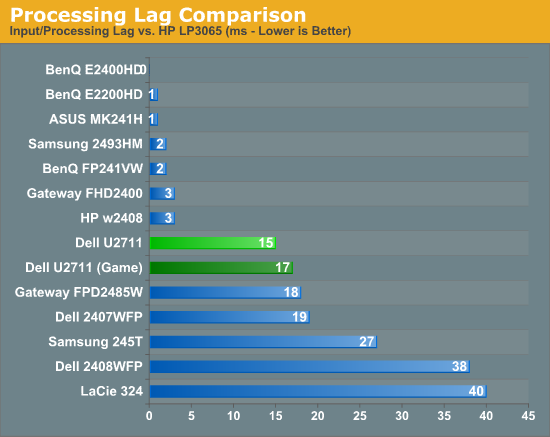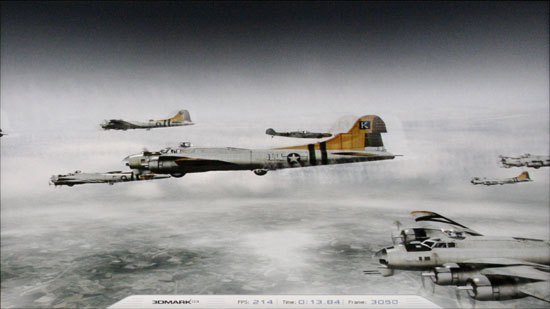Dell UltraSharp U2711: Quality has a Price
by Jarred Walton on January 22, 2010 2:00 AM EST- Posted in
- Displays
Dell U2711 Lag and Response Time
Some users are very concerned with display lag and pixel response time. For others, they really don't notice anything unless a particular display is very sluggish. I fall into the latter camp, though I do notice the processing lag when it's above ~40ms (e.g. on the Dell 2408WFP and LaCie 324, my mouse input just felt off.) To test for display lag, we run the Wings of Fury benchmark in 3DMark03, with the output set to the native LCD resolution - in this case 2560x1440. We clone the output to our reference LCD, an HP LP3065, snap a bunch of pictures, toss out any where the time readout isn't clear, and then average the remaining results (at least 10, and usually 20 or more).
As a reminder, the reference HP LP3065 is one of the best LCDs we currently possess in terms of not having display lag. (The lack of a built-in scaler probably has something to do with this.) While we know some of you would like us to compare performance to a CRT, few users have CRTs these days and all we're really interested in measuring is the relative lag. It's possible we will find an LCD that ends up with a negative result, meaning it's faster than the LP3065, but the best we have managed so far is a tie.

So far, all of the S-PVA panels we have tested show a significant amount of input lag, ranging from 18ms up to 40ms. In contrast, the TN and S-IPS panels show little to no processing lag (relative to the HP LP3065). The BenQ FP241VW with an S-MVA panel performs similarly to the TN and IPS panels, with an average display lag of 2ms - not something you would actually notice compared to other LCDs. What about the new U2711?
We tested with the "Graphics" setting and Adobe RGB as well as "Video" and "Game" - we figured the latter might disable some post-processing and result in less lag. That turned out to be incorrect, as our measured lag actually went up 2ms. However, in practice the settings are pretty much tied. That means the U2711 has around one frame of lag relative to our best LCDs, but it still has a lot less lag than our worst offenders. As stated already, I didn't notice lag in using the U2711 - just like I didn't notice lag on the 2407WFP or the FPD2485W. I did notice slight lag on the Samsung 245T and some clear lag on the 2408WFP and LaCie 324, but the threshold for lag varies and you'll need to determine if 15-17ms is too much or not for you. If you've tried any TN panels and still noticed lag, we would expect every current LCD to be above your "lag threshold".
 |
Despite what the manufacturers might advertise as their average pixel response time, we have found most of the LCDs are basically equal in this area - they all show roughly a one frame "lag", which equates to a response time of around 16ms. Some transitions are faster than others, but the above is representative of what we found in a study of numerous photos. If you look at the tail of the center plane, you can see a slight ghost image before and after the dominant frame. Some of that will come from the camera (we use a 1/120s shutter speed), but most of it comes from the LCD panel. In this case, the U2711 panel does outperform most LCDs that we've tested, where it was often possible to see at least three frames more clearly than the two slight ghosts in the above image.










153 Comments
View All Comments
FlyTexas - Sunday, January 24, 2010 - link
The difference between .225 and .233 is minor, but that wasn't really my point.The 30" panels are quite a bit larger than the 27" panel here, with a higher resolution, for the same money. The 30" Dell also uses a IPS panel, and while not quite as good as this new one, it is pretty close. Close enough for most people anyway.
Actually, if you want to talk about most people, the 28" HannsG LCD is perhaps the current bargin, I picked up one for my parents before Christmas for $288 from NewEgg. Not as good as the Dell panels, but plenty good for most people.
B3an - Saturday, January 23, 2010 - link
Err yes it would. Incase you have not realised, most people do not have insanely perfect eyesight. The dot pitch on the Dell 3008 would still be kind of small for most users. Let alone this display.Having said that i would like to the day when LCD monitors have dot pitches of 2 or 3 times as much as this Dell. So the display clarity is perrrfect and non-native resolutions would also look perfect. You also would not need AA in games anymore because of how tiny each screen pixel would be.
But also have Windows automatically detect this and increase the DPI to compensate so text is just as readable.
DanaGoyette - Saturday, January 23, 2010 - link
http://members.ping.de/~sven/dpi.html">http://members.ping.de/~sven/dpi.html -- handy javascript DPI calculator. Looks like this LCD is only 108 DPI.I've always thought of reviews that say, "oh no, high dpi means fonts will be tiny!" as "reviewer fail" -- high DPI only means fonts are tiny if you don't have your OS set to correct DPI. In fact, Windows 7 now sets a correct (or at least, rounded down to the next 25% scaling) on high-dpi displays.
I have a laptop with a 1920x1200, 15.4" LCD (147dpi), and it's awesomely wonderful for my eyes -- I can run HL2DM at native resolution, and not need antialiasing. When reading text, it's "halfway to paper" (printers give at least 300 dpi). The only downside to high-dpi is that some apps do break under DPI scaling.
Unfortunately, not even ONE single desktop LCD vendor has a display with equivalent DPI rating -- in fact, many are even lower than 96 dpi! At 19 inches, 1440x900 and 1280x1024 are both around 89 DPI -- on such displays, I can easily see the individual subpixels, and such displays can give me headaches.
If I wanted a second monitor, I'd have to pay tons of money for another laptop lcd and and lcd controller board!
Also, can anyone vouch for how it compares to that HP DreamColor LCD?
FlyTexas - Sunday, January 24, 2010 - link
Even Windows 7 doesn't really fix the DPI problem, simply because so many programs are poorly coded and don't understand anything other than standard Windows DPI settings...I used to use a pair of Dell 27" displays simply because I wanted 1920x1200 at that panel size under Windows XP to allow me to see anything. Not all of us are 23 years old with perfect vision you know. :)
With Windows 7, I moved to a pair of the Dell 30" displays because they handle the resolution better, even if it isn't perfect. That, combined with 200% scaling in IE8 and I'm mostly happy.
The reason for these displays was for work purposes (work paid for them, thankfully), I can comfortably display 2 side by side pages in MS Word and they are almost exactly real size, as compared to a physical piece of paper.
The resolution isn't there, but it is good enough for editing. The benefits in gaming are just a side bonus. :)
The downsize is that too many programs (Quickbooks is a good example) just were not designed for these displays and really don't take advantage of them, nor do they scale the interface up so you're looking at tiny icons...
What do I really want?
How about a pair of 40" OLED panels running at 10240x6400. That is about 300dpi and is 4x the resolution of these 30" panels, with better display technology.
Now how much would that cost me today? ;)
BTW, that resolution is over 65 million pixels, compared to the 4 million pixels on current 30" panels (and 2 million in a 1080P display). What kind of video card would be needed to drive that?!?
The0ne - Wednesday, January 27, 2010 - link
Your first sentence is enough for anyone not to fiddle around with the DPI setting :) Thx.Gholam - Saturday, January 23, 2010 - link
And then again, people who take 22" widescreens and set them to 1024x768 greatly outnumber those who want higher DPI.dszc - Tuesday, March 2, 2010 - link
It baffles me that Microsoft, even with Windows 7, has not yet properly addressed the display size issue. Their "font scaling" simply works very poorly or not at all on many apps. This is an OS issue. Very sad.DanaGoyette - Saturday, January 23, 2010 - link
Er, by "if I wanted another LCD", I mean, if I wanted another LCD with similar DPI rating -- otherwise, a window 4 inches tall on the laptop LCD would be 6 inches tall on the desktop LCD.Gholam - Saturday, January 23, 2010 - link
Buy a used IBM T221 - 3840x2400 resolution in 22.2 inches, .1245mm pixel pitch.Iketh - Friday, January 22, 2010 - link
A good example of games that really benefit from smaller dot pitches are flight simulators. CRTs still give the best picture for these, but this Dell monitor helps close the gap.